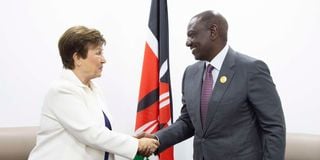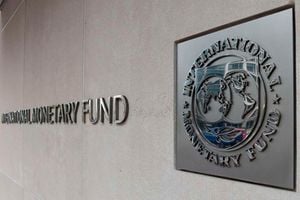
Haimanot Teferra IMF’s representative to Kenya.
In an exclusive interview with the Nation, International Monetary Fund (IMF) Representative to Kenya Haimanot Teferra tells Julians Amboko about the recent Sh150.1 billion loan to Kenya, details of the Extended Credit Facility and the Extended Fund Facility, the state of the economy and what’s next for the country.
Extended Credit Facility is IMF’s window for medium-term (typically three – five years) loans for low-income countries facing balance of payments (that is, export-import imbalance and currency related) pressures, while Extended Fund Facility is a window for soft loans for nations facing structural weaknesses (that is, flaws related to the design of an economy such as a large informal economy) that need time to address.
Sunday Nation: The January 17, 2024 meeting had quite a laden agenda. It was the sixth review of the ongoing Extended Credit Facility (ECF) and Extended Fund Facility (EFF) programme; it was the first review of the Resilience and Sustainability Facility and it also had discussions regarding Article IV (IMF’s periodic rigorous assessment of an economy’s fundamentals based on mission visits to the country). How would you characterise the meeting and its outcomes?
Haimanot Teferra: So, the meeting had several folds. It was the sixth review of the ongoing ECF/EFF supported programme and the (Kenyan) authority’s request for augmentation of financing under the programme. It was also the first review of the Resilience and Sustainability Facility programme (IMF’s window for loans targeted at climate change prevention and mitigation by borrowing countries) and the Article IV consultations — so it was a loaded meeting.
The discussion was not just about financing but also the policies in terms of the performance so far under the programmes; what have the authorities done in terms of their commitment and then also thinking about the way forward in terms of meeting the programme’s objectives; and then the Article IV of course looks at a medium to long-term kind of view in terms of things that are complementary to the programme but also some that are outside the programme in terms of structural issues and general overview of the economy.
The IMF has now handed Kenya the third and largest increase in the size of the ongoing programme, boosting it by $941.2 million or just about Sh150.1 billion. I realise that this augmentation effectively takes Kenya into IMF’s Exception Access Window, an avenue that allows Kenya to go beyond the prescribed limits of financing from the fund. Are things that bad to warrant access to this window?
When we held discussions with the (Kenyan) authorities in November, they made the request for augmentation of the programme. This augmentation of the ongoing programme is about $942.0 million and it will bring the total access under the IMF programme, including credit outstanding into the Exceptional Access territory.
It’s on this basis that the Executive Board (of the INF) approved the request for augmentation. Exceptional Access criteria has several requirements including strong policies to navigate Kenya out of the liquidity pressures it is facing currently and ensuring the policies being put in place ensure medium-term prospects are stronger and boost confidence. It’s just that the exposure of the fund gets larger.
The maturity of Kenya’s $2.0 billion Eurobond has been a source of grave concern for many. To what extent was the augmentation of the programme tied to aiding Kenya settle the maturity as it falls due and do you see global markets easing out in the near term to allow Kenya to raise debt and refinance?
In the past two months spreads on Kenya’s outstanding Eurobonds have eased but they are still higher than where they were in early 2022.
Global interest rates remain elevated making it very costly for Kenya to access the bond market to refinance the full $2.0 billion Eurobond ahead of its maturity in June.
Approval by the IMF’s Executive Board on January 17 of additional financing from the fund is to support Kenya during these uncertain times for frontier economies, not just Kenya because all frontier economies are facing difficulty in effective access to the bond market.
The additional funding coming from the fund is a recognition that what Kenya faces is a liquidity problem and they are implementing very important and strong policies and commitment to ensure that Kenya navigates out of this and realises strong potential in the medium-term.
The augmentation is approved to support the balance of payment pressures coming out of this Eurobond maturity in the near term.
Still on the issue of access to financing, on December 7, 2023 the IMF’s executive board temporarily increased access limits under the Poverty Reduction and Growth Trust (IMF’s window for provision of soft/low interest loans to the most vulnerable economies). Have Kenyan authorities sought or even hinted at triggering access to more financing under this window?
Basically, what this would mean is to allow countries like Kenya which have blended access to change the composition of financing from the fund to be tilted more towards the Poverty Reduction and Growth Trust which is the IMF’s concessional financing instrument.
Kenya is eligible to tap into the temporary higher access limits under the ongoing programme. However, at the time of reaching agreement with us in November on the financing and policy mix to bring the sixth review to the board, this decision was not made and this option was not available but subsequent to the decision and we have had a discussion with the authorities on the consideration of what this would entail for them to tap this.
Given the different policy calibration that is required under a different financing mix the authorities chose not to pursue this at this time.
The wild depreciation of the Kenya shilling has presented a headache for both public and private sector. As a matter of fact, the government has indicated that in the 12 months ended June 2023 alone, the depreciation of the shilling occasioned a Sh883.5 billion increase in the stock of public debt. What is the fund’s view about the shilling and monetary policy at large?
As part of the Article IV we do make an assessment of Kenya’s external position in 2023 and it has been assessed to be broadly aligned with the country’s medium-term economic fundamentals.
The depreciation over the past year actually reflects the greater role played by the exchange rate in responding to external shocks and the balance of payment pressures that the country is facing.
We believe that this has helped engender the needed adjustment in the current account balance which if you look at the previous assessment shows a gap and the adjustment has helped in narrowing the current account balance and improving Kenya’s external buffers in terms of adequate reserves.
So the depreciation is a reflection of the exchange rate playing its role as a shock absorber.

President William Ruto meets with IMF Managing Director Kristalina Georgieva.
The restructuring of State-owned enterprises is a key pillar of the programme between Kenya and the fund yet we don’t seem to hear or see much happening on the ground. Granted there was the challenge around the legal framework for privatisation but it wasn’t until November 2023 that we saw a new privatisation programme published by the Treasury. What’s the progress especially around Kenya Power and Kenya Airways?
Generally, I think there is progress related to the reform of State-owned enterprises even though it appears to be very slow.
On Kenya Power, the Cabinet approved an action plan in May 2023 to help improve its financial position and we understand that the Kenya Power board has approved the plan to implement this and has also approved a fair representation of the private sector in the board which should help strengthen corporate governance.
On Kenya Airways, we understand the (Kenyan) authorities are seeking the Cabinet’s guidance and have committed to come up with strategic options by April this year. We will have that discussion in the context of our next review mission in terms of the progress and what the strategic options and what has been decided.
It is important to note that the government has been servicing KQ’s guaranteed external debt because this has been called on. The reform on governance and oversight of State corporations is progressing.
The new ownership policy is an important milestone that has been approved and authorities are also updating the financial valuations of State corporations and they are also undertaking comprehensive assessment of the national government’s continued involvement in State corporations and government linked corporations. This work is still progressing.
One of the structural benchmarks at the conclusion of the fifth review last year was for the government to submit a new pump pricing formula for the country by October 31, 2023. This was of course on the back of subsidies that the fund had widely condemned as being ‘wasteful’. Did the authorities meet this target within the set time?
I think it is good to clarify that the structural benchmark was on review of how the fuel pricing formula worked over the last few years and communication of elimination of subsidies along with mechanisms to ensure that future domestic fuel price decisions are aligned with budget resources at all times.
The discussion that we had did not envisage a change of the actual pricing formula, the objective is to ensure that fuel price subsidy arrears do not re-emerge going forward and really to make sure that there are resources available and this is through the Petroleum Development Levy when needed to stabilise pump prices.
It is in that context that whereas the timeline was October 31st, 2023 it took longer given that the taskforces looking into this has taken time to make a decision and had communicated in a press release I believe on December 11 which concludes the objective of the benchmark.
Tell us about the Resilience and Sustainability Facility (RSF). What are some of the key themes that emerged from the first review that have paved way for the anticipated US$60.2 million disbursement?
At the time of the fifth review the RSF was approved and there are a number of reform measures that the authorities were planning to do under this instrument specifically trying to address climate finance.
The authorities have already completed one of the reforms that was slated for this review and this will unlock the resources associated with that. Each reform measure has a certain amount associated with it.
Kenya has a really good start on the RSF implementation and it seems that going forward the plans are progressing.










